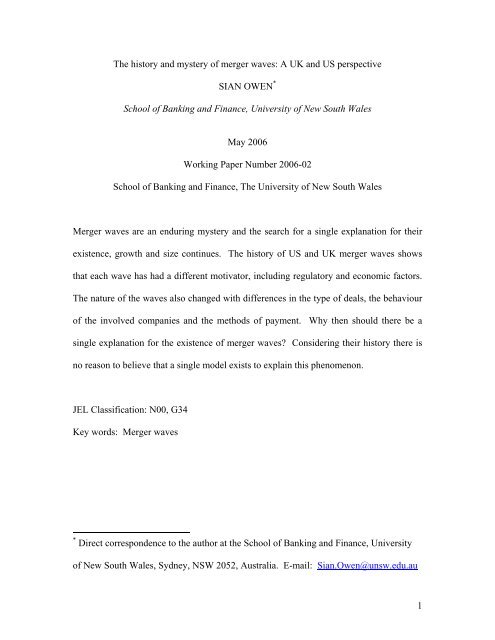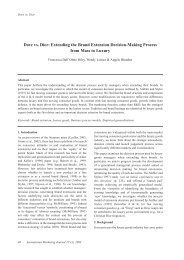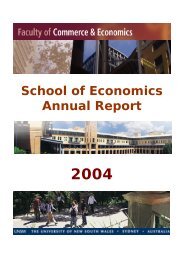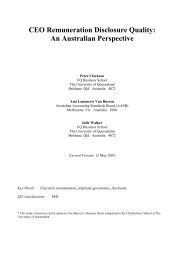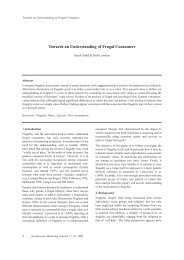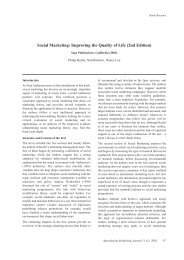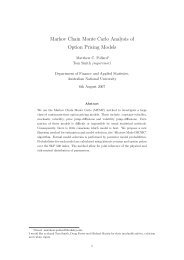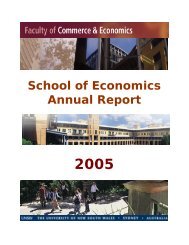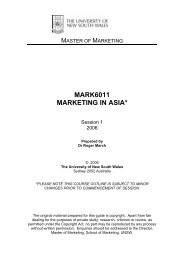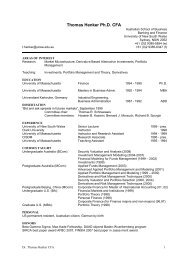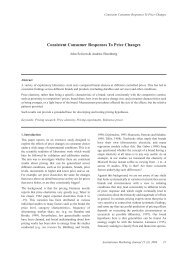The history and mystery of merger waves - University of New South ...
The history and mystery of merger waves - University of New South ...
The history and mystery of merger waves - University of New South ...
Create successful ePaper yourself
Turn your PDF publications into a flip-book with our unique Google optimized e-Paper software.
<strong>The</strong> <strong>history</strong> <strong>and</strong> <strong>mystery</strong> <strong>of</strong> <strong>merger</strong> <strong>waves</strong>: A UK <strong>and</strong> US perspectiveSIAN OWEN *School <strong>of</strong> Banking <strong>and</strong> Finance, <strong>University</strong> <strong>of</strong> <strong>New</strong> <strong>South</strong> WalesMay 2006Working Paper Number 2006-02School <strong>of</strong> Banking <strong>and</strong> Finance, <strong>The</strong> <strong>University</strong> <strong>of</strong> <strong>New</strong> <strong>South</strong> WalesMerger <strong>waves</strong> are an enduring <strong>mystery</strong> <strong>and</strong> the search for a single explanation for theirexistence, growth <strong>and</strong> size continues. <strong>The</strong> <strong>history</strong> <strong>of</strong> US <strong>and</strong> UK <strong>merger</strong> <strong>waves</strong> showsthat each wave has had a different motivator, including regulatory <strong>and</strong> economic factors.<strong>The</strong> nature <strong>of</strong> the <strong>waves</strong> also changed with differences in the type <strong>of</strong> deals, the behaviour<strong>of</strong> the involved companies <strong>and</strong> the methods <strong>of</strong> payment. Why then should there be asingle explanation for the existence <strong>of</strong> <strong>merger</strong> <strong>waves</strong>? Considering their <strong>history</strong> there isno reason to believe that a single model exists to explain this phenomenon.JEL Classification: N00, G34Key words: Merger <strong>waves</strong>* Direct correspondence to the author at the School <strong>of</strong> Banking <strong>and</strong> Finance, <strong>University</strong><strong>of</strong> <strong>New</strong> <strong>South</strong> Wales, Sydney, NSW 2052, Australia. E-mail: Sian.Owen@unsw.edu.au1
What causes a <strong>merger</strong> wave? Why do they grow to such excessive heights? Is it possibleto create a single model that will explain this behaviour? <strong>The</strong> analysis <strong>of</strong> the relationshipbetween <strong>merger</strong> <strong>and</strong> acquisition activity <strong>and</strong> the condition <strong>of</strong> the economy in thepreceding periods is the subject <strong>of</strong> a substantial body <strong>of</strong> work in which several modelshave been developed. <strong>The</strong> overriding problem with these models is that none <strong>of</strong> themwork very well outside the market or timeframe over which they were created. This hasresulted in the development <strong>of</strong> a second str<strong>and</strong> <strong>of</strong> research considering the level <strong>of</strong> <strong>merger</strong><strong>and</strong> acquisition activity over time, but a discussion <strong>of</strong> that particular area <strong>of</strong> the literatureis outside the remit <strong>of</strong> this paper. Instead by concentrating on the <strong>history</strong> <strong>and</strong> nature <strong>of</strong><strong>merger</strong> <strong>waves</strong> throughout the last century it is possible to posit the hypothesis that there isno one reason for the development <strong>of</strong> <strong>merger</strong> <strong>waves</strong>, nor is there any great <strong>mystery</strong>concerning their existence. Furthermore, there will never be a single explanation forthese events as they change fundamentally over time <strong>and</strong>, whilst some characteristicsseem to be consistent, many others are not. In short, <strong>merger</strong> <strong>waves</strong> are simply the result<strong>of</strong> a combination <strong>of</strong> economic <strong>and</strong> legal conditions that make activity <strong>of</strong> this sortappealing to companies at certain times.IA company is an entity which must respond continually to both internal <strong>and</strong>external pressures. Biological analogies are no longer a particularly fashionable way <strong>of</strong>viewing a firm but a certain resemblance exists nonetheless <strong>and</strong> can work well toillustrate the general life-cycle <strong>of</strong> a firm. A company is born, struggles to survive, growsthrough adolescence <strong>and</strong> then reaches maturity. Eventually, it will die, either through2
natural causes <strong>and</strong> a slow deterioration into old age or it may be absorbed into another,more predatory, firm. Merger <strong>and</strong> acquisition activity represents the second <strong>of</strong> theseoptions <strong>and</strong> provides a way for company assets to be transferred from one set <strong>of</strong> ownersto another. <strong>The</strong> literature that attempts to connect <strong>merger</strong> <strong>and</strong> acquisition activity toeconomic factors presumes that companies are reacting to external conditions rather thaninternal ones <strong>and</strong> also presumes that changes in the performance <strong>of</strong> the economy canimpact on the firm in such a manner that the company is inspired to enter the market forcorporate control.This str<strong>and</strong> <strong>of</strong> the existing literature begins with the economic disturbance theory iwhich suggests that changing economic conditions result in differences <strong>of</strong> opinionconcerning the value <strong>of</strong> companies. <strong>The</strong>se differences <strong>of</strong> opinion, in turn, result inincreased levels <strong>of</strong> <strong>merger</strong> <strong>and</strong> acquisition activity. This theory works particularly wellas a general statement but in order to be truly applicable, it is necessary to identifyprecisely which economic conditions are important in this relationship.<strong>The</strong> level <strong>of</strong> the stock markets is one factor that appears to be important in themajority <strong>of</strong> existing literature on this topic. Rising share prices are very <strong>of</strong>ten anindicator that a country’s economy is strengthening <strong>and</strong> this is followed by increasedpr<strong>of</strong>its for many firms. Naturally, this, in turn, can trigger increased levels <strong>of</strong> <strong>merger</strong> <strong>and</strong>acquisition activity ii . Another advantage <strong>of</strong> a rising stock market is that it facilitates<strong>merger</strong> <strong>and</strong> acquisition activity either by allowing companies to raise finance through theissue <strong>of</strong> new shares or allowing them to use new shares as the medium <strong>of</strong> exchange in thedeal. If this is coupled with falling interest rates then finance becomes particularly easyto raise <strong>and</strong> a major constraint to <strong>merger</strong> <strong>and</strong> acquisition activity is removed iii . It is3
interesting to note that these advantages seem to completely overweigh the fact that risingshare prices will also elevate the target firm’s market price.Another important factor in determining the level <strong>of</strong> <strong>merger</strong> <strong>and</strong> acquisitionactivity is the overall size <strong>of</strong> the economy. It is much easier to attempt deals <strong>of</strong> this sortin a large economy rather than in a small one iv . When a firm is considering entering themarket for corporate control, it is far easier to find a suitable partner for a <strong>merger</strong> or atarget for an acquisition when there are a lot <strong>of</strong> companies to choose from.When considering the behaviour <strong>of</strong> the market for corporate control there are alsoconsiderable differences between levels <strong>of</strong> activity in different industries. It is also wellknownthat the timing <strong>of</strong> <strong>merger</strong> <strong>and</strong> acquisition activity is industry specific. <strong>The</strong>sepatterns are determined by shocks to the industry which can result from changes ineconomic <strong>and</strong> regulatory conditions v . When a substantial shock is received by anindustry, it <strong>of</strong>ten becomes necessary for the firms within that industry to make somemajor changes in response. Under these circumstances, <strong>merger</strong> <strong>and</strong> acquisition activity is<strong>of</strong>ten the fastest form <strong>of</strong> response <strong>and</strong>, in some situations, may even be cheaper than thealternatives.An important caveat to all <strong>of</strong> the theories connecting economic factors <strong>and</strong> thelevel <strong>of</strong> <strong>merger</strong> <strong>and</strong> acquisition activity is that they all presume that external factors areable to drive decision making within the firm <strong>and</strong>, if necessary, override internalconcerns. This may, indeed, be the case but there will always be instances in whichinternal factors will either encourage or prohibit a firm’s entry into the market forcorporate control. More problematically, whilst these theories are all effective within thedata set used in their construction, they do not demonstrate the same accuracy when used4
on other data. Furthermore, whilst there are many similarities in the variables that areconsidered significant, there are also many differences <strong>and</strong> the interrelationships betweenvariables change from one paper to another.II<strong>The</strong> <strong>history</strong> <strong>of</strong> <strong>merger</strong> <strong>waves</strong> spans the twentieth century during which time there havebeen several <strong>merger</strong> <strong>waves</strong> in the US, each <strong>of</strong> which has been distinctly different from theothers.<strong>The</strong> first US <strong>merger</strong> wave began at the end <strong>of</strong> the nineteenth century <strong>and</strong> lasteduntil 1905. It is generally thought to have been triggered by the combination <strong>of</strong> a risingstock market <strong>and</strong> the introduction <strong>of</strong> the Sherman Antitrust Act (1890) which wasdesigned to prohibit any contract that would limit trade between different states <strong>and</strong>countries, but was not designed specifically to deal with the growing phenomenon <strong>of</strong><strong>merger</strong> <strong>and</strong> acquisition activity. It was also unable to prohibit any <strong>merger</strong> or acquisitionthat was organized using a stock for stock exchange. Worse yet, the Sherman Act madeit possible for companies to form near monopolies without any regulatory interference.Naturally, many companies sought to take advantage <strong>of</strong> this situation <strong>and</strong> the first US<strong>merger</strong> wave began as a result. During this time 1800 firms disappeared in this <strong>merger</strong>wave <strong>and</strong> approximately 71 formerly competitive industries were converted into virtualmonopolies during this wave; a massive reorganization <strong>of</strong> the industrial l<strong>and</strong>scape <strong>of</strong> theUnited States vi .Twenty years later there was another <strong>merger</strong> wave, this time reflecting the factthat the regulatory framework was changing again. <strong>The</strong> US courts now made it clear that5
they were prepared to forcibly take apart companies that had a monopolistic hold on theirindustries, as the 1911 break-up <strong>of</strong> St<strong>and</strong>ard Oil so clearly demonstrated. John DRockefeller had created St<strong>and</strong>ard Oil in 1868 in Pittsburgh, Pennsylvania <strong>and</strong> it thenspread rapidly throughout the United States gaining more <strong>and</strong> more subsidiaries as itwent. This one company represented all the power <strong>and</strong> wealth <strong>of</strong> the Rockefellerbusiness empire <strong>and</strong> St<strong>and</strong>ard Oil was well known for savage business practices thatdrove many <strong>of</strong> its competitors out <strong>of</strong> business. In 1911, however, the US Supreme Courtdecided to act <strong>and</strong> accused St<strong>and</strong>ard Oil <strong>of</strong> discriminatory practices, abuse <strong>of</strong> power <strong>and</strong>excessive control <strong>of</strong> its market. All <strong>of</strong> these had been acceptable under the Sherman Actbut the regulatory framework <strong>of</strong> the United States was changing <strong>and</strong> monopolisticbehaviour was no longer acceptable. St<strong>and</strong>ard Oil lost the ensuing court battle <strong>and</strong> wasforced to dismantle thirty-three <strong>of</strong> its most important subsidiaries <strong>and</strong> distribute the sharesto its existing shareholders. <strong>The</strong> company was also forbidden from creating a new trustto be the recipient <strong>of</strong> the shares effectively making it impossible for Rockefeller tomaintain control <strong>of</strong> the subsidiaries. <strong>The</strong> break-up <strong>of</strong> St<strong>and</strong>ard Oil represented the firststep towards the new <strong>merger</strong> legislation that was to be introduced in 1914, the ClaytonAct. This Act was put in place specifically to redress the weaknesses <strong>of</strong> the previouslegislation <strong>and</strong> it actively encouraged companies to form oligopolies instead <strong>of</strong>monopolies. Once again companies were eager to take advantage <strong>of</strong> the change <strong>and</strong> thesecond US <strong>merger</strong> wave was the result. As with the previous wave, the stock market wasrising <strong>and</strong> companies were able to issue equity as a way <strong>of</strong> financing <strong>merger</strong>s <strong>and</strong>acquisitions with relative ease. <strong>The</strong> wave was brought to a very abrupt end however with6
the advent <strong>of</strong> the Great Depression (1929) which caused the collapse <strong>of</strong> the US stockmarket <strong>and</strong> halted <strong>merger</strong> <strong>and</strong> acquisition activity almost overnight.<strong>The</strong> level <strong>of</strong> <strong>merger</strong> <strong>and</strong> acquisition activity fluctuated throughout the 1940s <strong>and</strong>1950s without ever rising to the extreme levels that characterize a wave. In 1950 theCeller-Kefauver Act was introduced which extended the Clayton Act <strong>and</strong> prohibited any<strong>merger</strong> or acquisition that was designed to give one firm a substantial degree <strong>of</strong> marketpower. As a result the number <strong>of</strong> horizontal deals was reduced to the bare minimum.This Act marked the first step towards <strong>merger</strong> regulations as they exist worldwide todaywith the emphasis on maintaining consumer choice in the market place.<strong>The</strong> next US wave activity began at the end <strong>of</strong> the 1950s <strong>and</strong> lasted until themiddle <strong>of</strong> the 1970s as the US economy underwent a strong period <strong>and</strong> the stock marketagain rose markedly. This resulted in the third US <strong>merger</strong> wave <strong>of</strong> the last century aspr<strong>of</strong>itable companies found themselves with large cash flows which they were unwillingto pay out to shareholders in the form <strong>of</strong> dividends <strong>and</strong> so turned to the market forcorporate control as a way <strong>of</strong> utilizing these funds. Throughout this period, the majority<strong>of</strong> deals were friendly arrangements <strong>and</strong> stock was the primary medium <strong>of</strong> exchange vii .<strong>The</strong> most notable feature <strong>of</strong> this <strong>merger</strong> wave was the preponderance <strong>of</strong> conglomeratedeals as companies actively sought to exp<strong>and</strong> into new markets <strong>and</strong> areas. <strong>The</strong> strength<strong>of</strong> this trend is illustrated by the fact that the number <strong>of</strong> conglomerate firms increasedfrom 8.3% <strong>of</strong> Fortune 500 firms in 1959 to 18.7% in 1969 viii . This change is almostcertainly due to the provisions <strong>of</strong> the Celler-Kefauver Act, which made horizontal<strong>merger</strong>s unpopular. <strong>The</strong> oil crisis <strong>of</strong> 1973 resulted in a sharp increase in inflation <strong>and</strong> aworld-wide economic downturn which marked the end <strong>of</strong> this <strong>merger</strong> wave.7
<strong>The</strong> fourth US <strong>merger</strong> wave took place in the 1980s <strong>and</strong> exceeded all <strong>of</strong> theproceeding <strong>waves</strong> in both the volume <strong>of</strong> transactions <strong>and</strong> in the size <strong>of</strong> the deals. Anothernotable characteristic <strong>of</strong> this wave was the much higher degree <strong>of</strong> hostility as companiesthat were previously considered untouchable, as their sheer size would make them safe,became the targets <strong>of</strong> unwelcome acquisition bids <strong>and</strong> fought vigorously to defendthemselves. Almost half <strong>of</strong> all major US companies were the recipients <strong>of</strong> an unsolicitedtakeover bid in the 1980s ix which is a clear indicator <strong>of</strong> the volume <strong>of</strong> transactions takingplace during this particular wave. This <strong>merger</strong> wave is also the one that has generated thegreatest volume <strong>of</strong> academic analysis <strong>and</strong> a plethora <strong>of</strong> different reasons have been putforward for its taking place. One possible reason is that the US government relaxed some<strong>of</strong> the restrictions on takeover activity that the earlier law had put in place x .Analternative explanation is that it represented a return to specialization after the excessivediversification <strong>and</strong> expansion <strong>of</strong> the 1960s wave. Many <strong>of</strong> the companies that were mostactive during the earlier <strong>merger</strong> wave found that there were incredible difficultiesinherent in managing a company spread over many different markets <strong>and</strong> countries.Many conglomerates failed entirely or were forced to divest considerably in order tosurvive after the 1960s <strong>merger</strong> wave <strong>and</strong> the 1980s wave saw the return <strong>of</strong> horizontaltakeovers as firms elected to concentrate on areas in which they were most pr<strong>of</strong>itable <strong>and</strong>effective. It is also worth noting that the 1980s was a period in which companies had torespond to a series <strong>of</strong> shocks that impacted on just about every type <strong>of</strong> company. <strong>The</strong>seincluded the growth <strong>of</strong> industrial deregulation, severe changes in the costs <strong>of</strong> inputs, suchas oil, <strong>and</strong> the rapid developments in technology that took place throughout this period.This tallies with the economic disturbance theory that was propounded by Gort xi which8
says that changes in external conditions result in differences <strong>of</strong> opinion concerning thevalue <strong>of</strong> companies <strong>and</strong> this, in turn, leads to increased levels <strong>of</strong> <strong>merger</strong> <strong>and</strong> acquisitionactivity. Another alternative arises from the fact that <strong>merger</strong>s <strong>and</strong> acquisitions, whilstexpensive <strong>and</strong> risky for the involved firms, may nonetheless be the most effective wayfor an entire industry to restructure in the wake <strong>of</strong> some form <strong>of</strong> economic shock xii .A more traditional approach to the 1980s <strong>merger</strong> wave takes the line that it wascaused by the proliferation <strong>of</strong> managerial inefficiency. Ineffective corporate governancemechanisms, coupled with equally poor managerial incentive schemes, allowed corporatemismanagement to flourish throughout the 1970s <strong>and</strong> into the 1980s. If stock marketswere truly efficient, any company with an ineffective management team would beidentified, the share price would drop <strong>and</strong>, ultimately, the firm would go bankrupt. Stockmarkets are not, however, fully efficient <strong>and</strong> so the market for corporate control steps into fill the gap. Companies with inefficient managers will be somewhat undervalued thusmaking them an appealing target for acquisition. After the purchase is complete, theineffective managers will be removed <strong>and</strong> the overall efficiency <strong>of</strong> the market isimproved xiii .<strong>The</strong> <strong>merger</strong> wave <strong>of</strong> the 1980s was also prompted by the popularity <strong>of</strong> debtfinanced transactions during this period. <strong>The</strong> use <strong>of</strong> debt in <strong>merger</strong>s <strong>and</strong> acquisitions wasnot a new innovation but became considerably more widespread during this period thanat any other time as leveraged buy-outs became popular forms <strong>of</strong> takeover. <strong>The</strong> use <strong>of</strong>junk bonds had the advantage <strong>of</strong> making it possible for very large companies to beconsidered potential takeover targets which added to the hostility <strong>of</strong> many transactions atthat time.9
<strong>The</strong> most recent <strong>merger</strong> wave, in the 1990’s, was the biggest one <strong>of</strong> all, vastlyexceeding all <strong>of</strong> the previous <strong>waves</strong> in both number <strong>of</strong> transactions <strong>and</strong> value. Whilst thetrend towards horizontal deals continued, in every other respect the 1990s <strong>merger</strong> wavewas very different to its predecessor. This wave was almost entirely friendly with just4% <strong>of</strong> deals being denoted as hostile xiv <strong>and</strong> the popularity <strong>of</strong> stock as the medium <strong>of</strong>exchange increased by approximately 50% compared to the previous <strong>merger</strong> wave. Onepotential explanation for the change in nature <strong>of</strong> deals from the hostility <strong>of</strong> the 1980s tothe more restrained activity <strong>of</strong> the 1990s is due to improvements in corporate governance.With the level <strong>and</strong> effectiveness <strong>of</strong> monitoring increasing greatly, it became much moredifficult for managers to enter into highly risky deals <strong>and</strong> forced them to consider morecarefully whether to enter the market for corporate control at all <strong>and</strong>, in the event thatthey decided to proceed, how they would enter the market xv . Faced with these sorts <strong>of</strong>constraints, many managers would think very carefully before attempting a <strong>merger</strong> oracquisition.IIIMerger <strong>waves</strong> in the UK have a far shorter <strong>history</strong> than those occurring in the US.Nothing akin to a substantial <strong>merger</strong> wave transpired before the 1960s although there wasa small wave in the 1920s which was inspired by the widespread introduction <strong>of</strong> massproduction technologies in the UK following the end <strong>of</strong> the First World War. <strong>The</strong>se newtechnologies resulted in a sharp increase in productivity, <strong>and</strong> a matching increase in shareprices. This sudden burst <strong>of</strong> productivity <strong>and</strong> pr<strong>of</strong>itability generated a spate <strong>of</strong> <strong>merger</strong>sthat resulted in substantial increases in concentration in many manufacturing industries.10
In 1948 the first step in the development <strong>of</strong> UK <strong>merger</strong> policy was taken with thepassing <strong>of</strong> the Monopolies <strong>and</strong> Restrictive Practices Act which created a Commission tolook into deals that might be adverse to the public good. <strong>The</strong> terms <strong>of</strong> reference for theCommission, however, were vague <strong>and</strong> the criteria to be used in determining the publicgood were equally indistinct. Not surprisingly, this had no noticeable effect on the level<strong>of</strong> <strong>merger</strong> <strong>and</strong> acquisition activity which continued to fluctuate gently over time but withno sign <strong>of</strong> a <strong>merger</strong> wave for more than a decade. <strong>The</strong> first real <strong>merger</strong> wave in the UKwas in the 1960s <strong>and</strong> coincided with the internationalization <strong>of</strong> the World economy. <strong>The</strong>British government decided that large firms were needed to compete effectively on theinternational stage <strong>and</strong> to achieve this goal the Industrial Reorganization Corporation(IRC) was created with a brief to encourage the development <strong>of</strong> such companies throughhorizontal <strong>merger</strong>s which made up the majority <strong>of</strong> <strong>merger</strong>s in this wave. Amongst thetop 200 manufacturing companies in 1964, 39 (19.5%) were involved in <strong>merger</strong> oracquisition activity within the next five years xvi . Given the low levels <strong>of</strong> <strong>merger</strong> <strong>and</strong>acquisition activity prior to this time, this was a major increase in activity. During thesame period, the Monopolies <strong>and</strong> Mergers Act (1965) was passed which prohibited any<strong>merger</strong> or acquisition that was contrary to the public good, <strong>and</strong> created the Mergers <strong>and</strong>Monopolies Commission (MMC) to rule on contentious cases. This law focusedpredominantly on horizontal <strong>merger</strong>s as the public good was generally associated withmarket share <strong>and</strong> consumer choice <strong>and</strong>, as a result, the popularity <strong>of</strong> this type <strong>of</strong> dealshould have been limited to a considerable degree but any deal backed by the IRC wasexempt from the legislation which allowed the <strong>merger</strong> wave to occur, irrespective <strong>of</strong> itsdeleterious impact on competition in many markets. This wave experienced a partial11
drop after 1968 but then grew to another peak in 1972. Throughout this latter period, theproportion <strong>of</strong> horizontal deals dropped, although they were still by far the most populartype <strong>of</strong> purchase, <strong>and</strong> conglomerate deals grew correspondingly xvii , reflecting the growingimpact <strong>of</strong> the earlier legislation. <strong>The</strong> legal framework was further reinforced in 1973with the Fair Trading Act which formalized the procedures for regulating <strong>merger</strong> <strong>and</strong>acquisition activity in the UK <strong>and</strong> created the Office <strong>of</strong> Fair Trading (OFT). <strong>The</strong> OFTexamines each deal <strong>and</strong> decides whether it should be referred to the Mergers <strong>and</strong>Monopolies Commission (now know as the Competition Commission) for a detailedanalysis <strong>of</strong> its potential impact.<strong>The</strong> next period <strong>of</strong> excessive <strong>merger</strong> <strong>and</strong> acquisition activity took place in the1980s <strong>and</strong> marked a change in emphasis when compared to the previous <strong>waves</strong>. Prior tothis time the <strong>waves</strong> had been mostly about increasing the size <strong>of</strong> companies but in the1980s the emphasis changed to the control <strong>of</strong> corporate assets as a commodity. Duringthis period, the most recent development in <strong>merger</strong> <strong>and</strong> acquisition policy took place witha comment written in an internal memo by the then Secretary <strong>of</strong> State for Trade <strong>and</strong>Industry, Normal Tebbit, who wrote that he considered the primary grounds for a referralto the MMC would be an adverse impact on competition. However, the actual criteria formaking a referral are somewhat unclear. As a result, the OFT has historically referredonly a very small proportion <strong>of</strong> qualifying bids. Between the introduction <strong>of</strong> the Mergers<strong>and</strong> Monopolies Act in 1965 <strong>and</strong> 1985 there were 3540 <strong>merger</strong>s <strong>and</strong> acquisitions whichmet the criteria for a referral to the MMC. Of these only 107 were actually referred <strong>and</strong>in 31 <strong>of</strong> these cases the bidding company elected to withdraw the bid before anyjudgement was h<strong>and</strong>ed down xviii . This is echoed by more recent data which shows that <strong>of</strong>12
915 deals that qualified for investigation between 1998 <strong>and</strong> 2001; only 42 were referredfor a full investigation xix . This provides a compelling reason why the numbers <strong>of</strong>horizontal <strong>merger</strong>s have not been limited by the prevailing legal framework, despite the<strong>of</strong>ten quoted “Tebbit Guidelines”. Throughout the early part <strong>of</strong> the 1980s the stockmarket was rising sharply reflecting growing pr<strong>of</strong>its <strong>and</strong> business confidence. <strong>The</strong>financial services industry had just been deregulated which further contributed to thegrowth <strong>of</strong> the wave. This period <strong>of</strong> excessive restructuring also incorporated somefeatures <strong>of</strong> <strong>merger</strong> <strong>and</strong> acquisition activity previously unseen in the UK <strong>and</strong> importedfrom the US; increased hostility, the use <strong>of</strong> leverage <strong>and</strong> a large number <strong>of</strong> buy-outs all <strong>of</strong>which took place in this wave but had not previously been notable features <strong>of</strong> the marketfor corporate control in the UK. <strong>The</strong> London Stock Exchange suffered a major crash in1987 but this was not enough to stop the wave, however, which had sufficient momentumto keep going until 1989.<strong>The</strong> most recent <strong>merger</strong> wave in the UK took place in the 1990s <strong>and</strong> was againspurred on by deregulation <strong>of</strong> more British industries coupled with the policy <strong>of</strong>privatizing Government owned assets which took place through the last years <strong>of</strong> the1980s <strong>and</strong> the early 1990s, as typified by the sales <strong>of</strong> British Telecom (1984), British Gas(1986) <strong>and</strong> British Rail (1993). <strong>The</strong>se changes resulted in the need for extensiverestructuring on many difference levels <strong>of</strong> British industry <strong>and</strong> prompted the <strong>merger</strong>wave. Unlike the 1980s there was relatively little hostility during this period <strong>and</strong> manycompanies changed their perspective on <strong>merger</strong>s <strong>and</strong> acquisitions to take a more balancedapproach when compared to the excesses <strong>of</strong> the previous decade. This change inperspective was prompted by the findings <strong>of</strong> the Cadbury Report (1992) which was13
commissioned by the London Stock Exchange to investigate the state <strong>of</strong> corporategovernance in the UK. <strong>The</strong> Cadbury Report made a large number <strong>of</strong> recommendationsthat increased the level <strong>of</strong> monitoring to which Boards <strong>of</strong> Directors were subjected <strong>and</strong>also increased the degree <strong>of</strong> transparency in company decision making. <strong>The</strong>serecommendations, coupled with proposals decreasing the power <strong>of</strong> individual Boardmembers <strong>and</strong> increasing the independence <strong>of</strong> Non-executive directors, made managersmuch more accountable for their actions <strong>and</strong> far less able to make the type <strong>of</strong> large,hostile, possibly unwise, acquisition attempts that characterised much <strong>of</strong> the 1980s.IVThis article illustrates that there is no <strong>mystery</strong> to <strong>merger</strong> <strong>waves</strong>. Quite simply, theycannot be modelled because some <strong>of</strong> their characteristics change over time. <strong>The</strong> clearimplication <strong>of</strong> this is that whilst some <strong>of</strong> the motivating factors remain consistentlyimportant, there are always other factors that are unique to one particular wave <strong>and</strong> do notapply to any other. In general terms, <strong>merger</strong> <strong>waves</strong> are prompted when finance becomesreadily available at a time when the regulatory framework allows companies to enter into<strong>merger</strong> or acquisition activity. However, shocks to the economy such as deregulation arenot constant <strong>and</strong> only impact on certain industries at certain times. Thus the search for asingle explanation for <strong>merger</strong> <strong>waves</strong> will never be satisfied, but taking into account the<strong>history</strong> <strong>of</strong> this phenomenon, this should not be unexpected.14
Footnote ReferencesAndrade, G., Mitchell, M. <strong>and</strong> Stafford, E. '<strong>New</strong> Evidence <strong>and</strong> Perspectives on Mergers',Journal <strong>of</strong> Economic Perspectives 15 (2001), pp. 103-120.Fairburn, J. '<strong>The</strong> Evolution <strong>of</strong> Merger Policy in Britain', in M. Bishop <strong>and</strong> J. Kay eds.,European Mergers <strong>and</strong> Merger Policy, 1993), pp. 239-277.Golbe, D. L. <strong>and</strong> White, L. J. 'A Time Series Analysis <strong>of</strong> Mergers <strong>and</strong> Acquisitions in theU.S. Economy.' in A. J. Auerbach ed., Corporate Takeovers: Causes <strong>and</strong>Consequences, (Chicago, 1988), pp. 265-310.Gort, M. 'An Economic Disturbance <strong>The</strong>ory <strong>of</strong> Mergers.' Quarterly Journal <strong>of</strong> Economics83, no. 4 (1969), pp. 624-642.Holmstrom, B. <strong>and</strong> Kaplan, S. N. 'Corporate Governance <strong>and</strong> Merger Activity in theU.S.: Making Sense <strong>of</strong> the 1980s <strong>and</strong> 1990s', NBER Working Paper 8220 (2001)Hughes, A. 'Mergers <strong>and</strong> Economic Performance in the Uk: A Survey <strong>of</strong> the EmpiricalEvidence', in M. Bishop <strong>and</strong> J. Kay eds., European Mergers <strong>and</strong> Merger Policy,1993), pp. 9-95.Melicher, R. W., Ledolter, J. <strong>and</strong> D'Antonio, L. J. 'A Time Series Analysis <strong>of</strong> AggregateMerger Activity', Review <strong>of</strong> Economics <strong>and</strong> Statistics 65 (1983), pp. 423-430.Mitchell, M. L. <strong>and</strong> Mulherin, J. H. '<strong>The</strong> Impact <strong>of</strong> Industry Shocks on Takeover <strong>and</strong>Restructuring Activity', Journal <strong>of</strong> Financial Economics 41 (1996), pp. 193-229.Rumelt, R. P., Strategy, Structure <strong>and</strong> Economic Performance (Boston, MA., 1974).Scherer, F. M. 'Corporate Takeovers: <strong>The</strong> Efficiency Arguments', Journal <strong>of</strong> EconomicPerspectives 2, no. 1 (1988), pp. 69-82.15
Shleifer, A. <strong>and</strong> Vishny, R. W. 'Takeovers in the '60s <strong>and</strong> the '80s: Evidence <strong>and</strong>Implications', Strategic Management Journal 12 (1991), pp. 51-59.Steiner, P. O., Mergers: Motives, Effects, Policies, 1975).Sudarsanam, S., Creating Value from Mergers <strong>and</strong> Acquisitions: <strong>The</strong> Challenges(London, 2003).16
Footnotesi M. Gort, "An Economic Disturbance <strong>The</strong>ory <strong>of</strong> Mergers.," Quarterly Journal <strong>of</strong>Economics 83, no. 4 (1969).ii P. O. Steiner, Mergers: Motives, Effects, Policies (<strong>University</strong> <strong>of</strong> Michigan Press, 1975).iii R. W. Melicher, J Ledolter, <strong>and</strong> L. J D'Antonio, "A Time Series Analysis <strong>of</strong> AggregateMerger Activity," Review <strong>of</strong> Economics <strong>and</strong> Statistics 65 (1983).iv D. L. Golbe <strong>and</strong> L. J. White, "A Time Series Analysis <strong>of</strong> Mergers <strong>and</strong> Acquisitions inthe U.S. Economy.," in Corporate Takeovers: Causes <strong>and</strong> Consequences, ed. A. JAuerbach (Chicago: <strong>University</strong> <strong>of</strong> Chicago Press, 1988).v M. L. Mitchell <strong>and</strong> J. H. Mulherin, "<strong>The</strong> Impact <strong>of</strong> Industry Shocks on Takeover <strong>and</strong>Restructuring Activity," Journal <strong>of</strong> Financial Economics 41 (1996).vi S Sudarsanam, Creating Value from Mergers <strong>and</strong> Acquisitions: <strong>The</strong> Challenges(London: FT Prentice Hall, 2003).vii A. Shleifer <strong>and</strong> R. W. Vishny, "Takeovers in the '60s <strong>and</strong> the '80s: Evidence <strong>and</strong>Implications," Strategic Management Journal 12 (1991).viii R. P Rumelt, Strategy, Structure <strong>and</strong> Economic Performance (Boston, MA.: HarvardBusiness School Press, 1974).ix Mitchell <strong>and</strong> Mulherin, "<strong>The</strong> Impact <strong>of</strong> Industry Shocks on Takeover <strong>and</strong> RestructuringActivity."x Shleifer <strong>and</strong> Vishny, "Takeovers in the '60s <strong>and</strong> the '80s: Evidence <strong>and</strong> Implications."xi Gort, "An Economic Disturbance <strong>The</strong>ory <strong>of</strong> Mergers."xii Mitchell <strong>and</strong> Mulherin, "<strong>The</strong> Impact <strong>of</strong> Industry Shocks on Takeover <strong>and</strong> RestructuringActivity."17
xiii F. M. Scherer, "Corporate Takeovers: <strong>The</strong> Efficiency Arguments," Journal <strong>of</strong>Economic Perspectives 2, no. 1 (1988).xiv G. Andrade, M. Mitchell, <strong>and</strong> E. Stafford, "<strong>New</strong> Evidence <strong>and</strong> Perspectives onMergers," Journal <strong>of</strong> Economic Perspectives 15 (2001).xv B Holmstrom <strong>and</strong> S. N. Kaplan, "Corporate Governance <strong>and</strong> Merger Activity in theU.S.: Making Sense <strong>of</strong> the 1980s <strong>and</strong> 1990s," (NBER, 2001).xvi A Hughes, "Mergers <strong>and</strong> Economic Performance in the Uk: A Survey <strong>of</strong> the EmpiricalEvidence," in European Mergers <strong>and</strong> Merger Policy, ed. M Bishop <strong>and</strong> J Kay (Oxford<strong>University</strong> Press, 1993).xvii Sudarsanam, Creating Value from Mergers <strong>and</strong> Acquisitions: <strong>The</strong> Challenges.xviii J Fairburn, "<strong>The</strong> Evolution <strong>of</strong> Merger Policy in Britain," in European Mergers <strong>and</strong>Merger Policy, ed. M Bishop <strong>and</strong> J Kay (Oxford Univerity Press, 1993).xix Sudarsanam, Creating Value from Mergers <strong>and</strong> Acquisitions: <strong>The</strong> Challenges.18


